A violin plot is a compact display of a continuous distribution. It is a
blend of geom_boxplot() and geom_density(): a
violin plot is a mirrored density plot displayed in the same way as a
boxplot.
geom_violin(
mapping = NULL,
data = NULL,
stat = "ydensity",
position = "dodge",
...,
draw_quantiles = NULL,
trim = TRUE,
scale = "area",
na.rm = FALSE,
orientation = NA,
show.legend = NA,
inherit.aes = TRUE
)
stat_ydensity(
mapping = NULL,
data = NULL,
geom = "violin",
position = "dodge",
...,
bw = "nrd0",
adjust = 1,
kernel = "gaussian",
trim = TRUE,
scale = "area",
na.rm = FALSE,
orientation = NA,
show.legend = NA,
inherit.aes = TRUE
)Arguments
- mapping
Set of aesthetic mappings created by
aes()oraes_(). If specified andinherit.aes = TRUE(the default), it is combined with the default mapping at the top level of the plot. You must supplymappingif there is no plot mapping.- data
The data to be displayed in this layer. There are three options:
If
NULL, the default, the data is inherited from the plot data as specified in the call toggplot().A
data.frame, or other object, will override the plot data. All objects will be fortified to produce a data frame. Seefortify()for which variables will be created.A
functionwill be called with a single argument, the plot data. The return value must be adata.frame, and will be used as the layer data. Afunctioncan be created from aformula(e.g.~ head(.x, 10)).- position
Position adjustment, either as a string, or the result of a call to a position adjustment function.
- ...
Other arguments passed on to
layer(). These are often aesthetics, used to set an aesthetic to a fixed value, likecolour = "red"orsize = 3. They may also be parameters to the paired geom/stat.- draw_quantiles
If
not(NULL)(default), draw horizontal lines at the given quantiles of the density estimate.- trim
If
TRUE(default), trim the tails of the violins to the range of the data. IfFALSE, don't trim the tails.- scale
if "area" (default), all violins have the same area (before trimming the tails). If "count", areas are scaled proportionally to the number of observations. If "width", all violins have the same maximum width.
- na.rm
If
FALSE, the default, missing values are removed with a warning. IfTRUE, missing values are silently removed.- orientation
The orientation of the layer. The default (
NA) automatically determines the orientation from the aesthetic mapping. In the rare event that this fails it can be given explicitly by settingorientationto either"x"or"y". See the Orientation section for more detail.- show.legend
logical. Should this layer be included in the legends?
NA, the default, includes if any aesthetics are mapped.FALSEnever includes, andTRUEalways includes. It can also be a named logical vector to finely select the aesthetics to display.- inherit.aes
If
FALSE, overrides the default aesthetics, rather than combining with them. This is most useful for helper functions that define both data and aesthetics and shouldn't inherit behaviour from the default plot specification, e.g.borders().- geom, stat
Use to override the default connection between
geom_violin()andstat_ydensity().- bw
The smoothing bandwidth to be used. If numeric, the standard deviation of the smoothing kernel. If character, a rule to choose the bandwidth, as listed in
stats::bw.nrd().- adjust
A multiplicate bandwidth adjustment. This makes it possible to adjust the bandwidth while still using the a bandwidth estimator. For example,
adjust = 1/2means use half of the default bandwidth.- kernel
Kernel. See list of available kernels in
density().
Orientation
This geom treats each axis differently and, thus, can thus have two orientations. Often the orientation is easy to deduce from a combination of the given mappings and the types of positional scales in use. Thus, ggplot2 will by default try to guess which orientation the layer should have. Under rare circumstances, the orientation is ambiguous and guessing may fail. In that case the orientation can be specified directly using the orientation parameter, which can be either "x" or "y". The value gives the axis that the geom should run along, "x" being the default orientation you would expect for the geom.
Aesthetics
geom_violin() understands the following aesthetics (required aesthetics are in bold):
xyalphacolourfillgrouplinetypesizeweight
Learn more about setting these aesthetics in vignette("ggplot2-specs").
Computed variables
- density
density estimate
- scaled
density estimate, scaled to maximum of 1
- count
density * number of points - probably useless for violin plots
- violinwidth
density scaled for the violin plot, according to area, counts or to a constant maximum width
- n
number of points
- width
width of violin bounding box
References
Hintze, J. L., Nelson, R. D. (1998) Violin Plots: A Box Plot-Density Trace Synergism. The American Statistician 52, 181-184.
See also
geom_violin() for examples, and stat_density()
for examples with data along the x axis.
Examples
p <- ggplot(mtcars, aes(factor(cyl), mpg))
p + geom_violin()
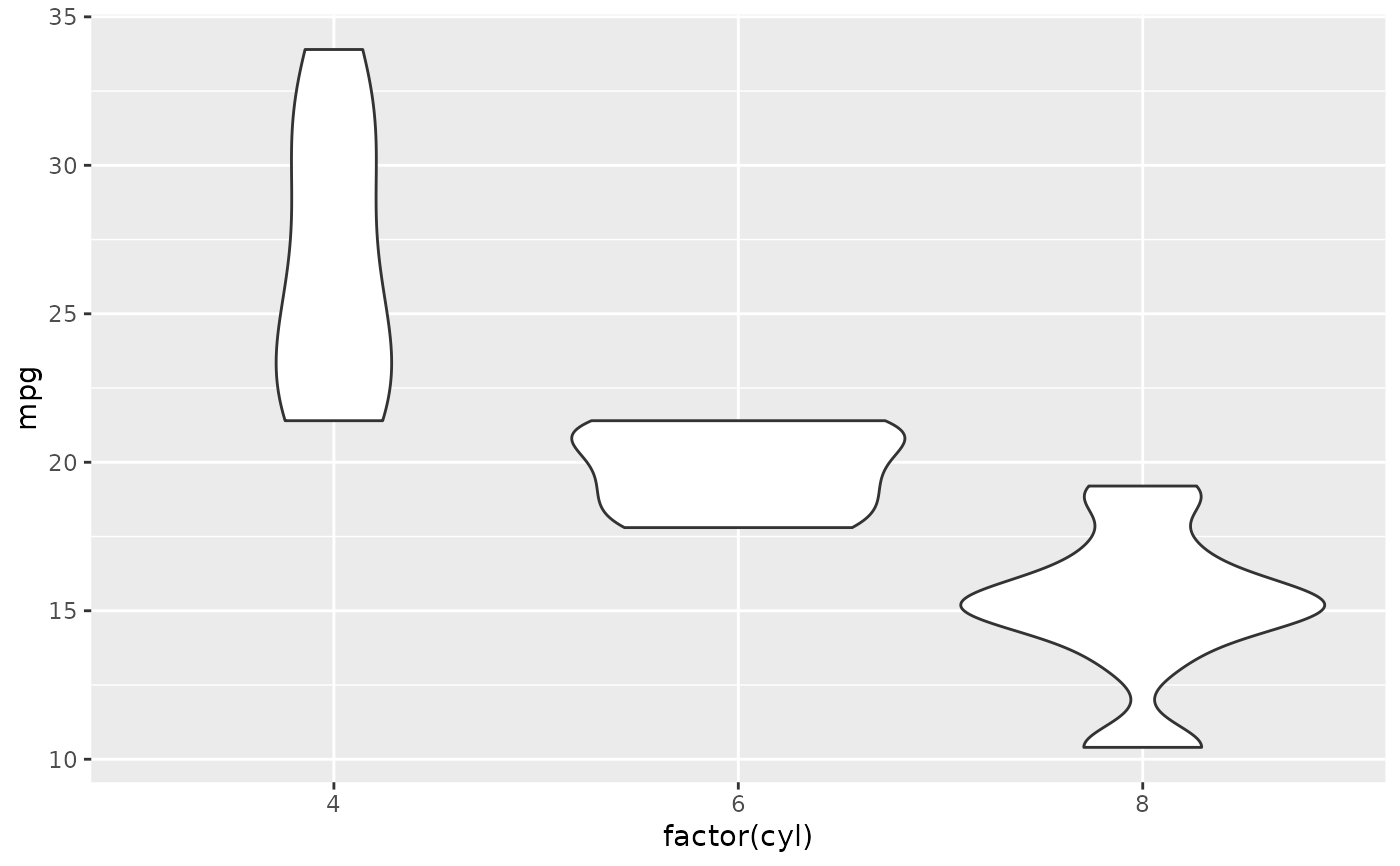 # Orientation follows the discrete axis
ggplot(mtcars, aes(mpg, factor(cyl))) +
geom_violin()
# Orientation follows the discrete axis
ggplot(mtcars, aes(mpg, factor(cyl))) +
geom_violin()
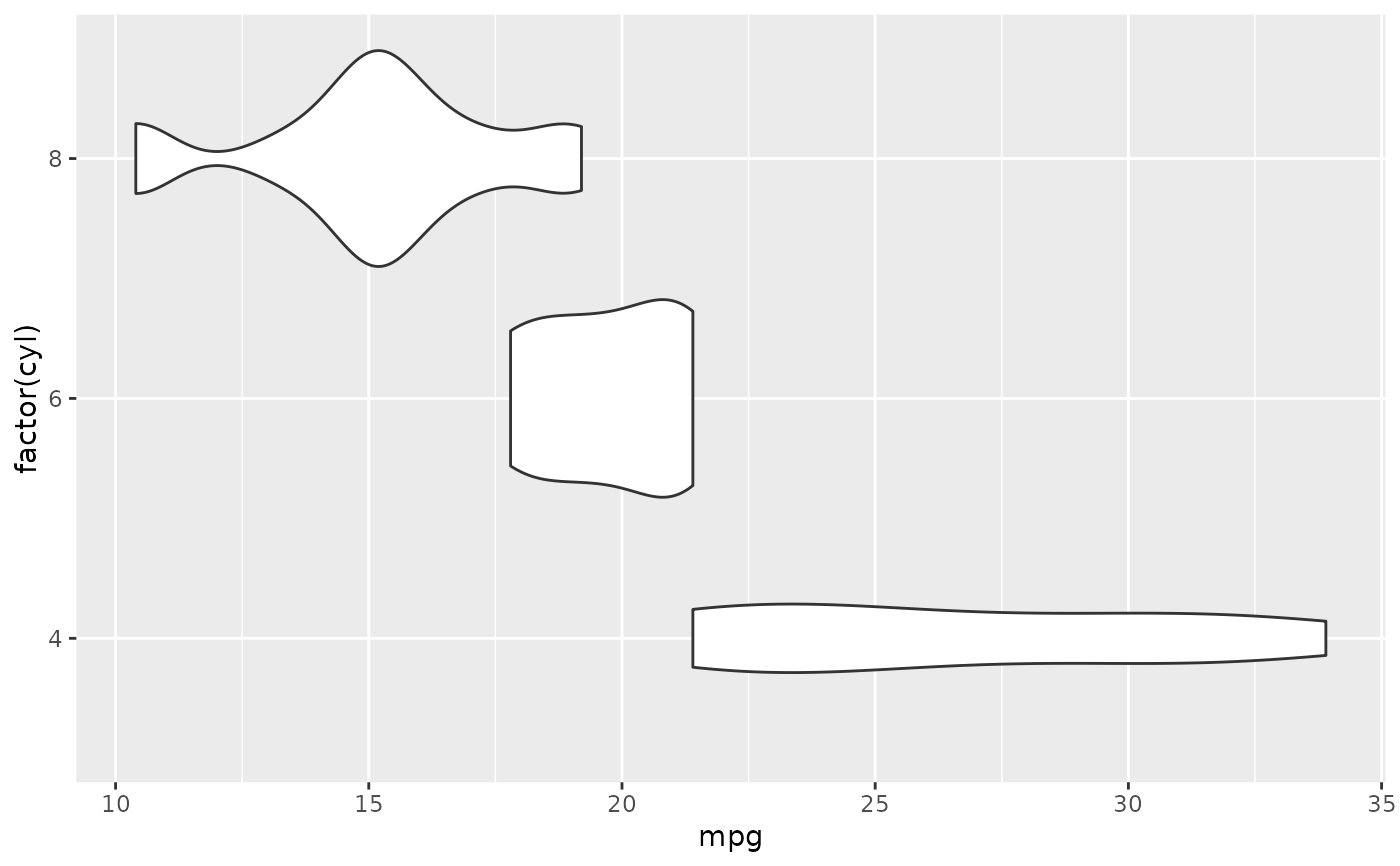 # \donttest{
p + geom_violin() + geom_jitter(height = 0, width = 0.1)
# \donttest{
p + geom_violin() + geom_jitter(height = 0, width = 0.1)
 # Scale maximum width proportional to sample size:
p + geom_violin(scale = "count")
# Scale maximum width proportional to sample size:
p + geom_violin(scale = "count")
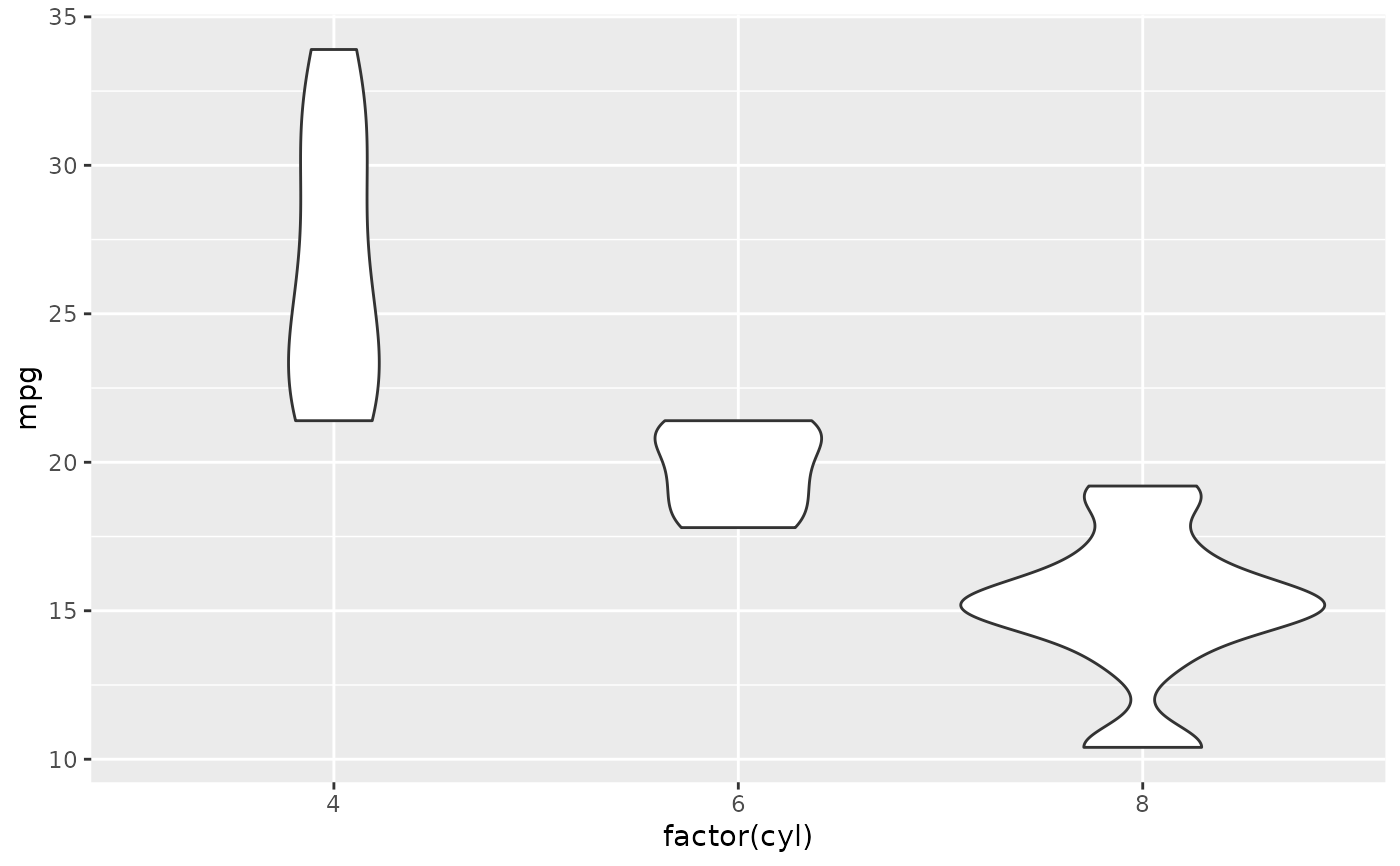 # Scale maximum width to 1 for all violins:
p + geom_violin(scale = "width")
# Scale maximum width to 1 for all violins:
p + geom_violin(scale = "width")
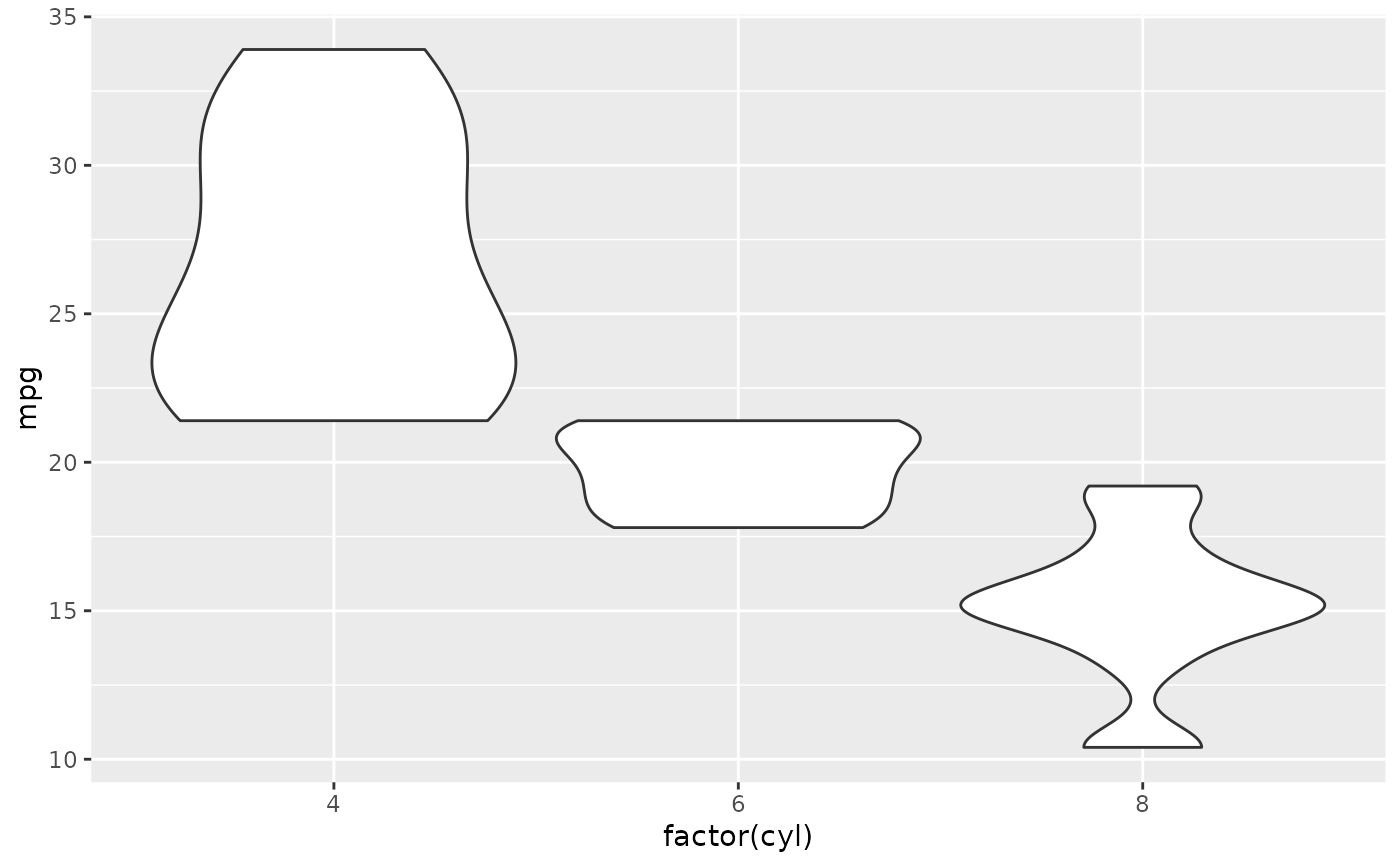 # Default is to trim violins to the range of the data. To disable:
p + geom_violin(trim = FALSE)
# Default is to trim violins to the range of the data. To disable:
p + geom_violin(trim = FALSE)
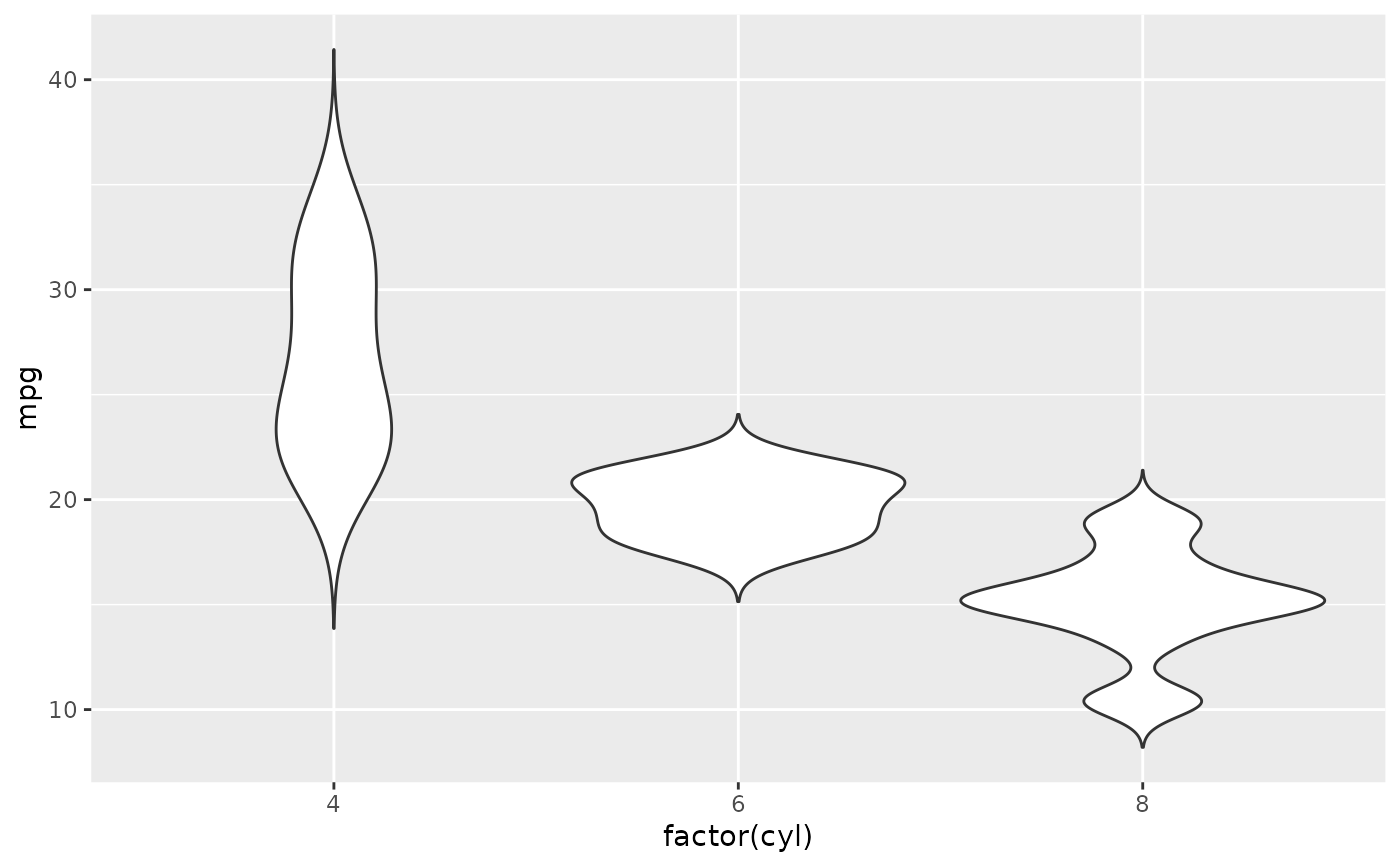 # Use a smaller bandwidth for closer density fit (default is 1).
p + geom_violin(adjust = .5)
# Use a smaller bandwidth for closer density fit (default is 1).
p + geom_violin(adjust = .5)
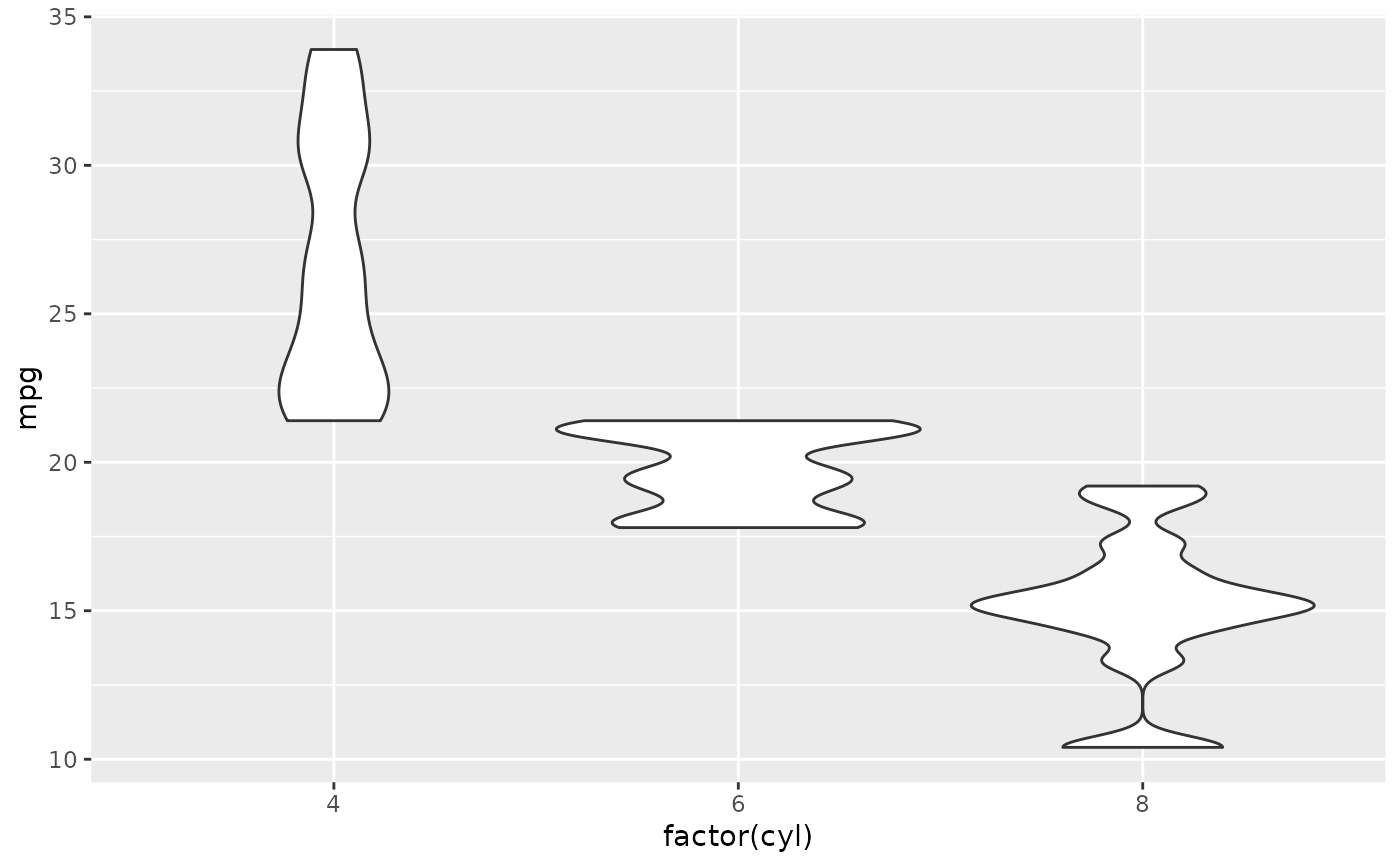 # Add aesthetic mappings
# Note that violins are automatically dodged when any aesthetic is
# a factor
p + geom_violin(aes(fill = cyl))
# Add aesthetic mappings
# Note that violins are automatically dodged when any aesthetic is
# a factor
p + geom_violin(aes(fill = cyl))
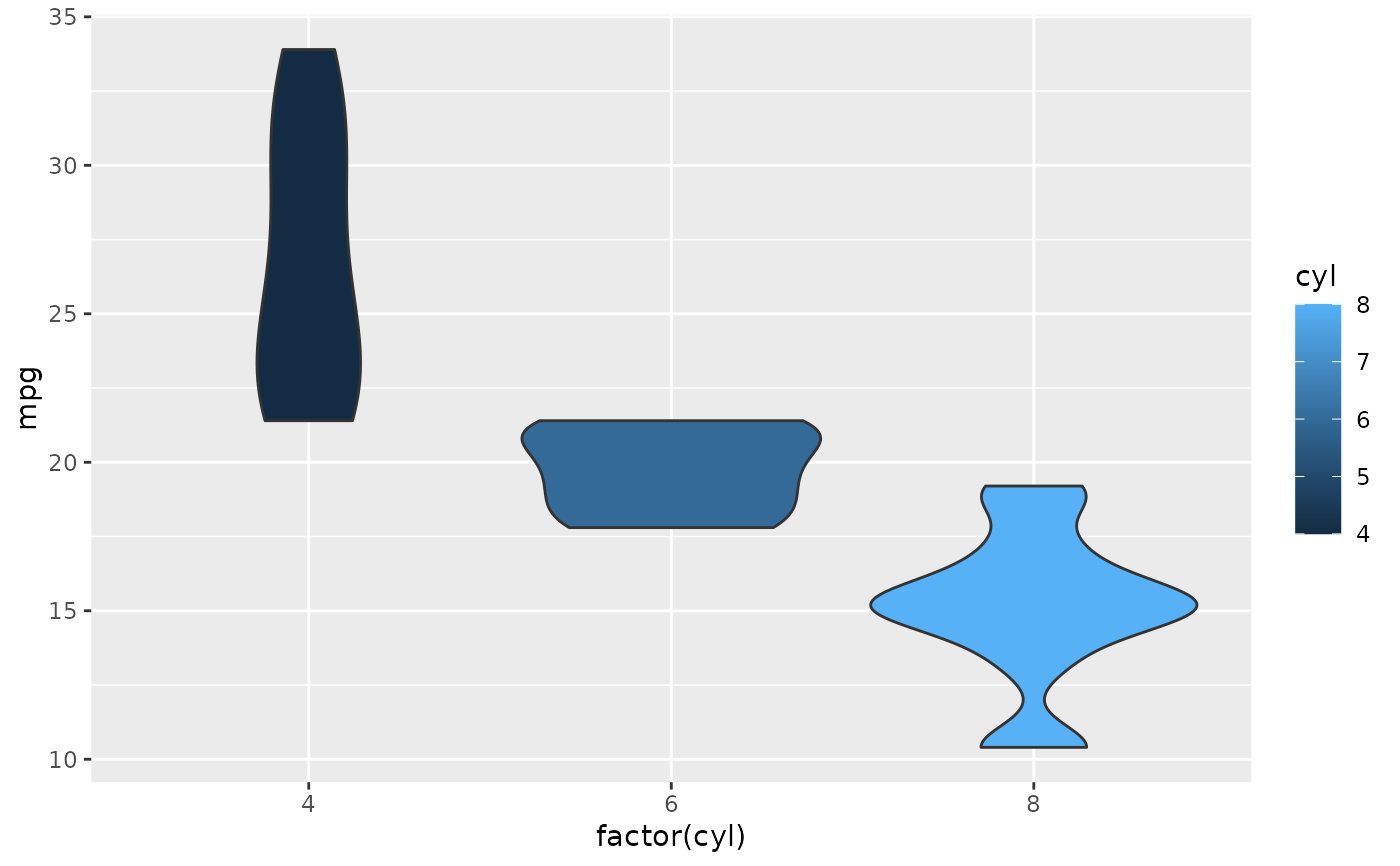 p + geom_violin(aes(fill = factor(cyl)))
p + geom_violin(aes(fill = factor(cyl)))
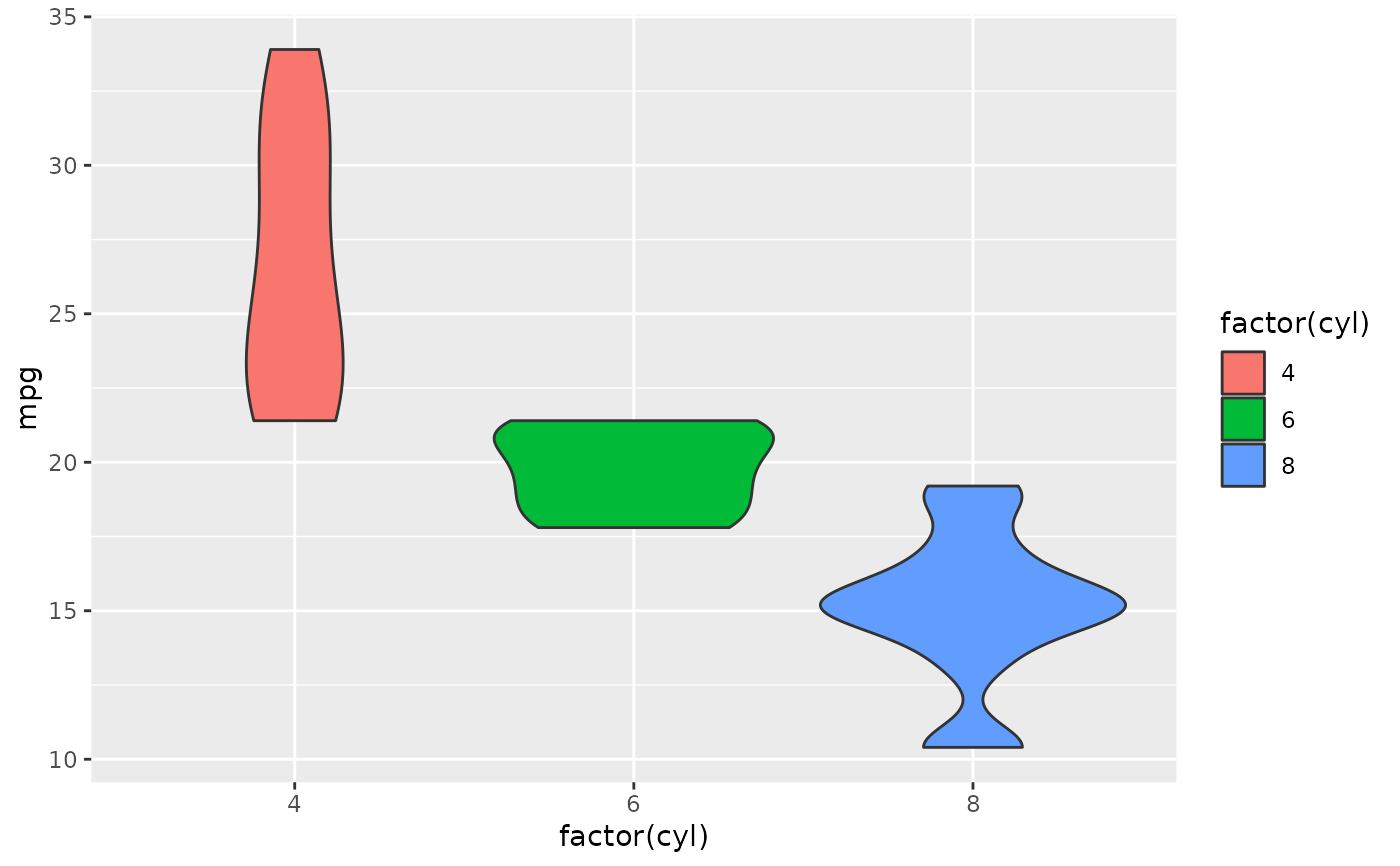 p + geom_violin(aes(fill = factor(vs)))
#> Warning: Groups with fewer than two data points have been dropped.
p + geom_violin(aes(fill = factor(vs)))
#> Warning: Groups with fewer than two data points have been dropped.
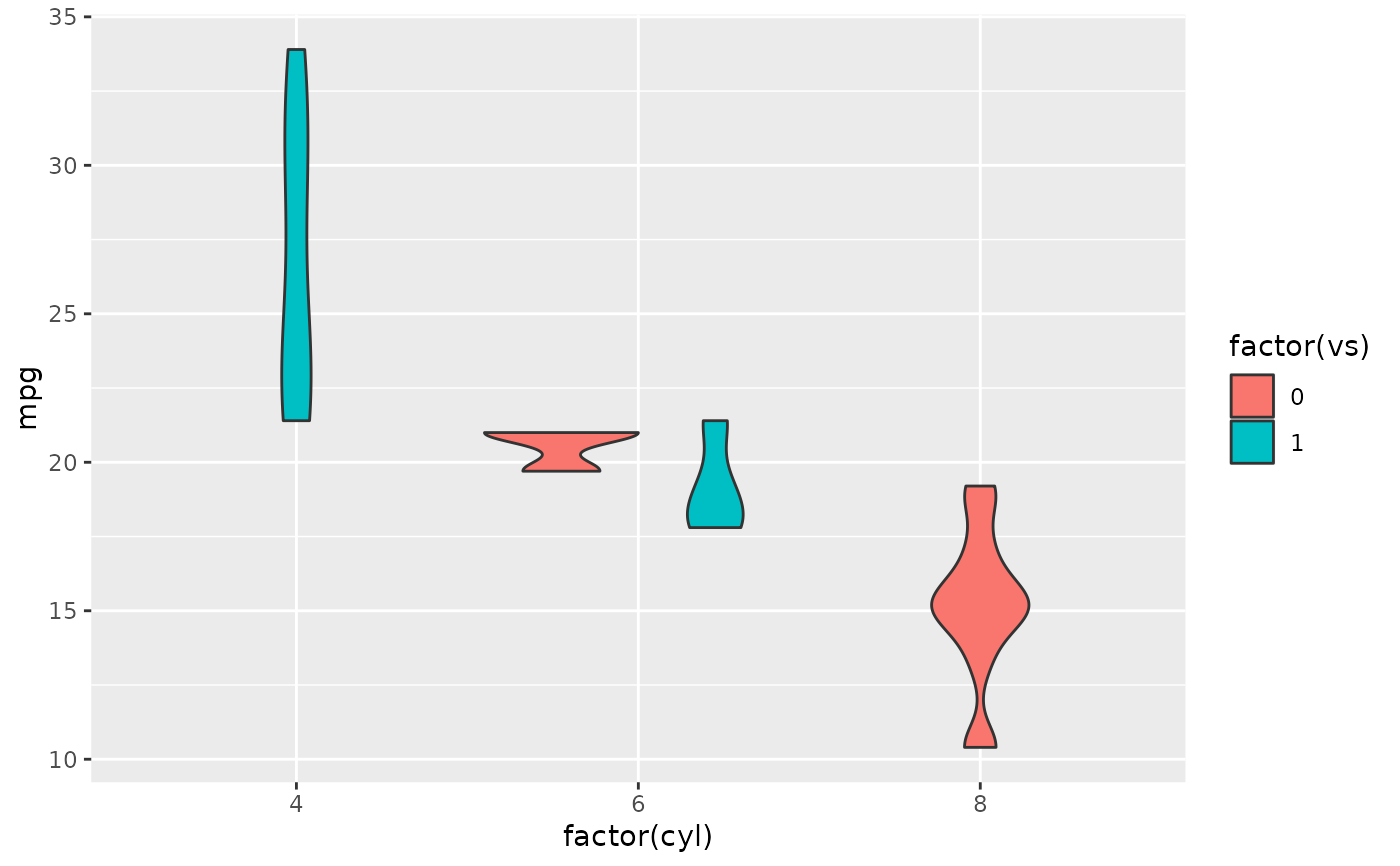 p + geom_violin(aes(fill = factor(am)))
p + geom_violin(aes(fill = factor(am)))
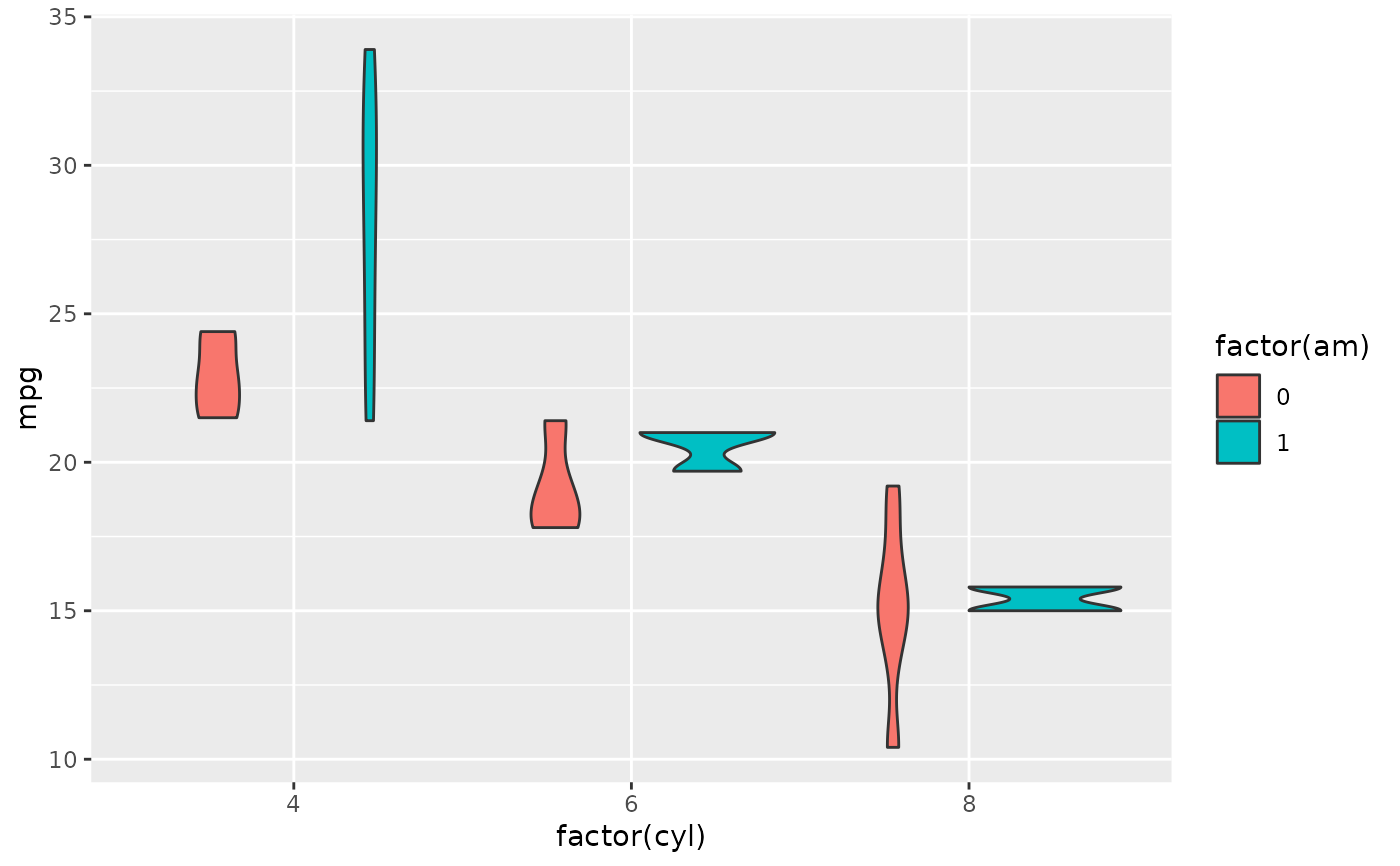 # Set aesthetics to fixed value
p + geom_violin(fill = "grey80", colour = "#3366FF")
# Set aesthetics to fixed value
p + geom_violin(fill = "grey80", colour = "#3366FF")
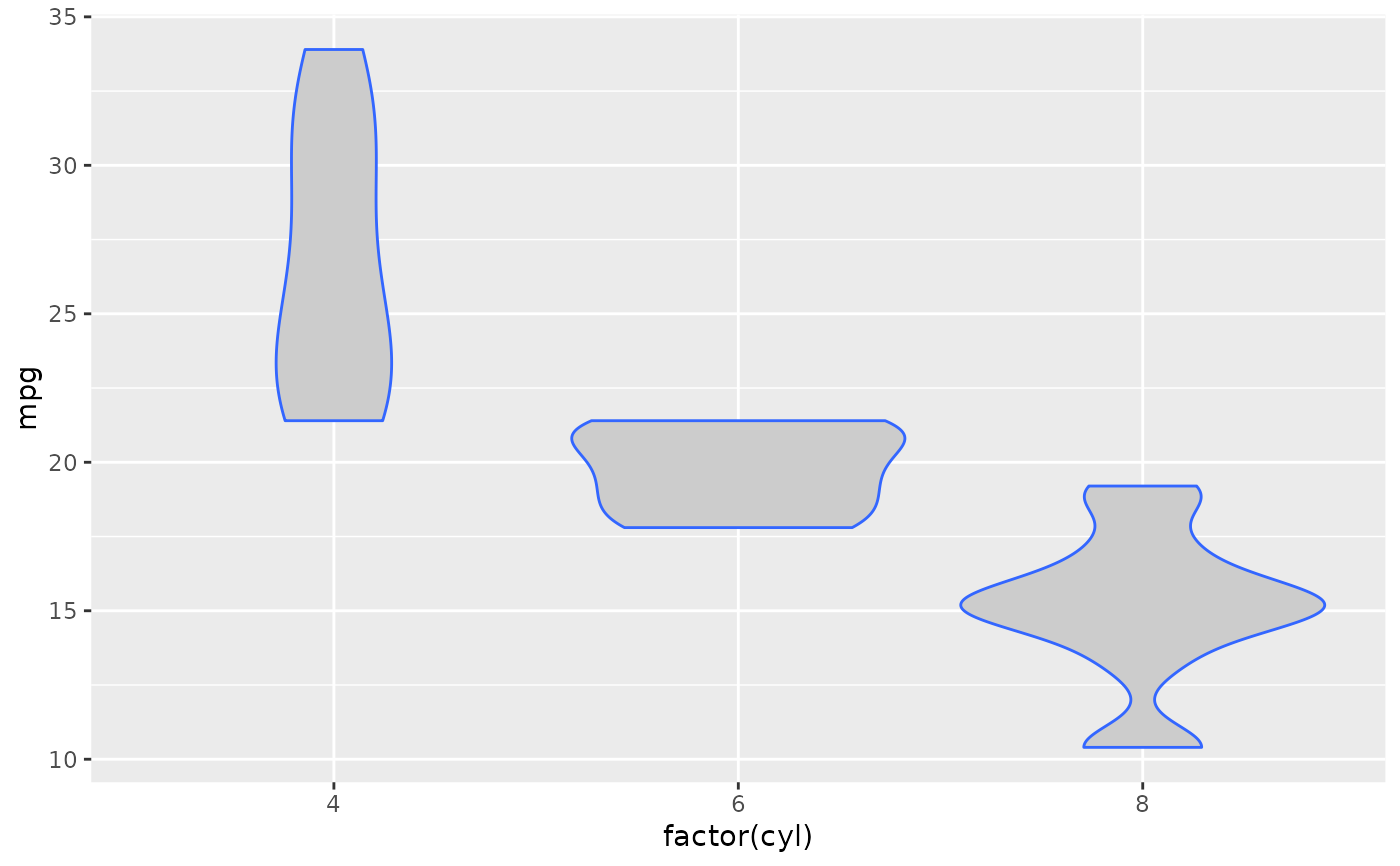 # Show quartiles
p + geom_violin(draw_quantiles = c(0.25, 0.5, 0.75))
# Show quartiles
p + geom_violin(draw_quantiles = c(0.25, 0.5, 0.75))
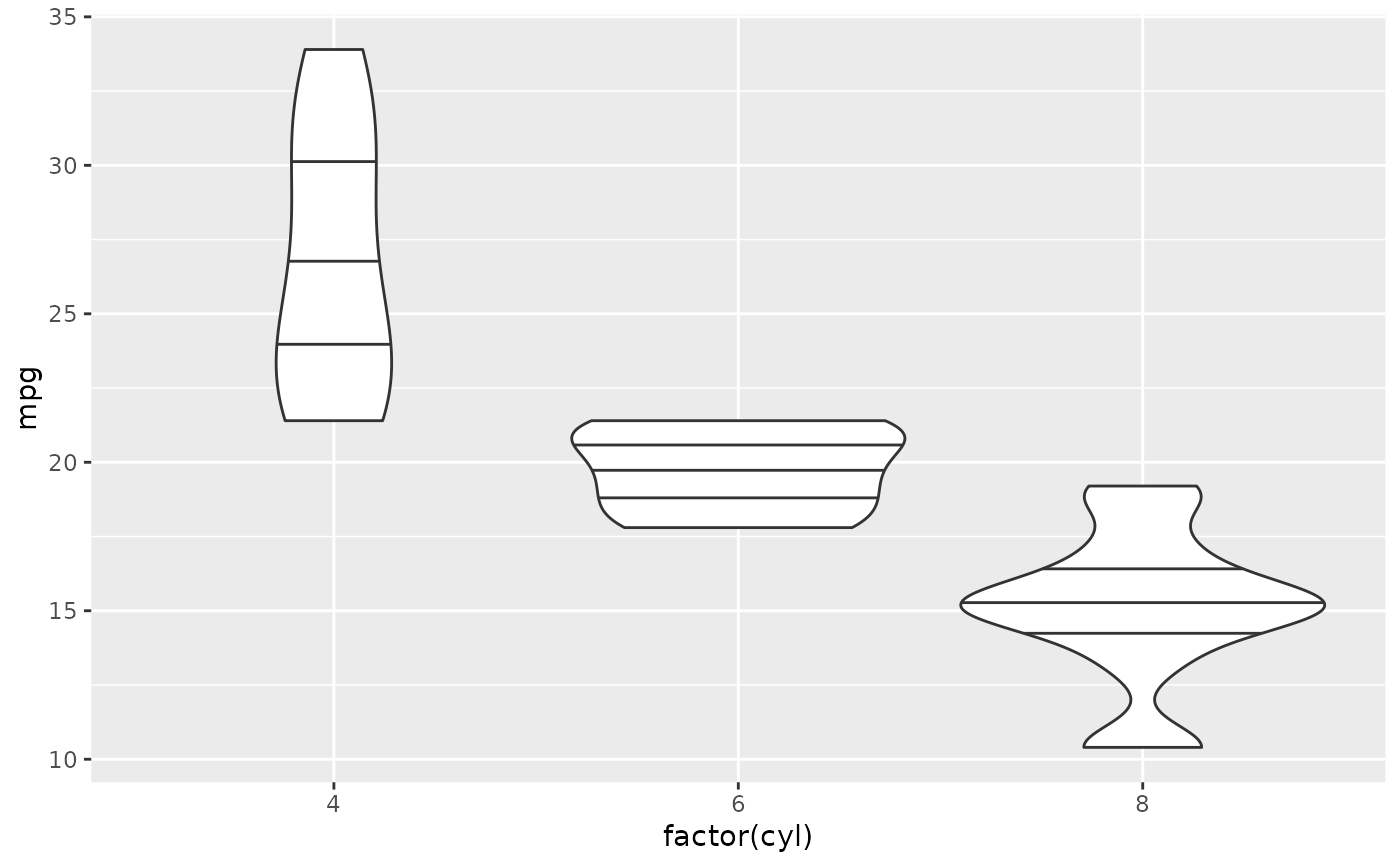 # Scales vs. coordinate transforms -------
if (require("ggplot2movies")) {
# Scale transformations occur before the density statistics are computed.
# Coordinate transformations occur afterwards. Observe the effect on the
# number of outliers.
m <- ggplot(movies, aes(y = votes, x = rating, group = cut_width(rating, 0.5)))
m + geom_violin()
m +
geom_violin() +
scale_y_log10()
m +
geom_violin() +
coord_trans(y = "log10")
m +
geom_violin() +
scale_y_log10() + coord_trans(y = "log10")
# Violin plots with continuous x:
# Use the group aesthetic to group observations in violins
ggplot(movies, aes(year, budget)) +
geom_violin()
ggplot(movies, aes(year, budget)) +
geom_violin(aes(group = cut_width(year, 10)), scale = "width")
}
#> Warning: Removed 53573 rows containing non-finite values (stat_ydensity).
#> Warning: Groups with fewer than two data points have been dropped.
# Scales vs. coordinate transforms -------
if (require("ggplot2movies")) {
# Scale transformations occur before the density statistics are computed.
# Coordinate transformations occur afterwards. Observe the effect on the
# number of outliers.
m <- ggplot(movies, aes(y = votes, x = rating, group = cut_width(rating, 0.5)))
m + geom_violin()
m +
geom_violin() +
scale_y_log10()
m +
geom_violin() +
coord_trans(y = "log10")
m +
geom_violin() +
scale_y_log10() + coord_trans(y = "log10")
# Violin plots with continuous x:
# Use the group aesthetic to group observations in violins
ggplot(movies, aes(year, budget)) +
geom_violin()
ggplot(movies, aes(year, budget)) +
geom_violin(aes(group = cut_width(year, 10)), scale = "width")
}
#> Warning: Removed 53573 rows containing non-finite values (stat_ydensity).
#> Warning: Groups with fewer than two data points have been dropped.
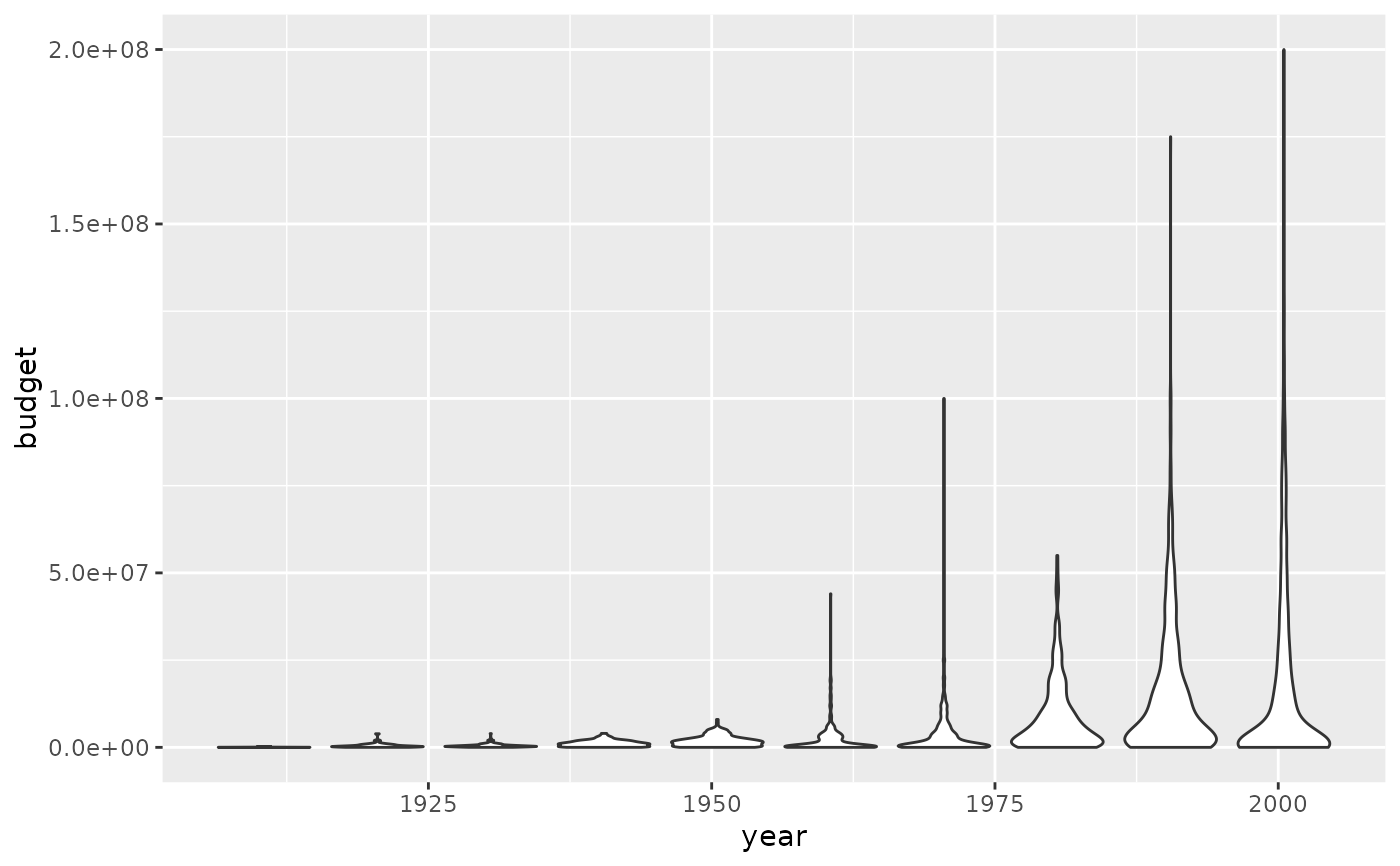 # }
# }